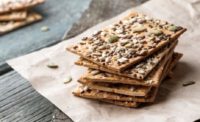Consumers, producers evolving on ancient grains
An expert from Dakota MB discusses emerging trends in grains.

Courtesy of Dakota MB
When shopping for breads, buns, rolls, snacks, and other items incorporating grains, consumers increasingly want a blend of new ingredients and tastes, with some of their fond familiar flavors. This desire for a melange of novel and traditional products is serving to keep food producers on their toes. To learn more about the current and emerging trends, and how producers are working to deliver on what consumers want, Snack Food & Wholesale Bakery checked in with Tarrand Fiesel, vice president of sales and marketing with DakotaMB.
Jenni Spinner: Could you please tell a bit about DakotaMB—the history of the company (and its two halves), the markets you serve, key products/services, and what sets you apart?
Tarrand Fiesel: DakotaMB is a family-owned business in America’s heartland that partners with some of the largest bakeries, snack producers, and cereal manufacturers in the world. The Matthaei family opened its first bakery in Germany in 1686, and over the next 300 years, the family immigrated to the United States; opened bakeries in Kansas City and Tacoma, Wash.; developed Roman Meal Bread, one of the first multigrain breads available in the United States; and pivoted to milling and blending.
Today fifth generation CEO W. Peter Matthaei steers the family of companies, which was renamed to DakotaMB to recognize its core focus of milling and blending. The company supplies the food industry with value-added grains, multigrain blends, bases, functional mixes, granola, and toppings.
JS: How are consumers’ interests and desires around grains in their snacks, bakery goods, and other products evolving? Please talk about the trends that have impacted products in recent years.
TF: As a company with an extensive history in the bread industry, we’ve seen a significant change in how bakeries and snack food manufacturers approach the grains and flours they use. The bread aisle used to look identical with seas of white breads and white buns that had roughly the same ingredient lists. Things have changed, and now the bread aisle is a cornucopia of white and brown breads made with refined flours, whole wheat flours, whole grains, and multigrain blends.
Today, we’re helping companies create multigrain blends for a variety of categories, including:
- Cereal: Consumers wanting to start their day off with a nutritious breakfast are turning to multigrain cereals and granolas.
- Biscuits/Cookies: Better-for-you cookies are trending as a permissibly indulgent treat for consumers during any eating occasion.
- Crackers: Multigrain blends create an upscale cracker experience with enhanced texture and taste.
JS: What challenges do snack and bakery producers face in delivering products that give consumers what they’re looking for, whether they’re formulating new items or tweaking existing ones?
TF: The most exciting aspect of developing a multigrain blend is creating a blend that hits all the desired product attributes. When creating a multigrain blend, we work closely with a bakery or snack food manufacturer’s R&D department to consider these attributes:
- Nutritional Profile: Do you have any specific nutrient goals you’re trying to hit, such as fiber levels or other macro- and micro-nutrients? Creating a product that hits specific requirements will alter the grains and seeds used in a multigrain blend.
- Texture: Do you want to impart additional texture in a product, or do you want the multigrain blend to seamlessly blend into the product’s existing texture? We can mill grains into cuts, flakes, or flours to ensure a bakery or snack food attains the desired texture.
- Usage: Do you want your multigrain blend to top a product or be incorporated into the dough?
- Visual: Some food manufacturers want their multigrain blends to be seen by consumers. Others want their blends to “disappear” into the product. Blends for both types of products can be created.
- Label Statements: Are you targeting a gluten-free product? Or maybe you just want to scream “ancient grains” on the package? Understanding what types of label statements you’re looking to make will help determine the perfect multigrain blend.
JS: How can your company help them cross the finish line? How do you help them figure out the right ingredients, formulation, and processing conundrums, etc.?
TF: DakotaMB specializes in developing multigrain blends using a combination of whole grains, ancient grains, and seeds. Our extensive list of products, vast experience, and knowledgeable R&D team help companies formulate new products or lower the costs of existing ones.
We understand how price, usage level, and supply chain considerations impact grain selection and can help food manufacturers navigate the opportunities and challenges of incorporating a multigrain blend or ancient grain into a product.
Related: Grains deliver health benefits, versatility, and taste
Looking for a reprint of this article?
From high-res PDFs to custom plaques, order your copy today!







